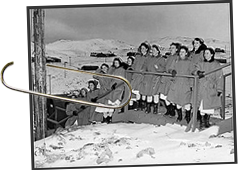

|
CHART #
00690006969 |
PRIMARY FACILITY
Vestibriüm University Hospital |
CODE
|
ATTENDING PHYSICIAN
Süurd |
TYPE
x |
AU
x |
|
DISPOSITION (STATUS)
In progress |
ARTICLE (JOURNAL REF)
Advanced C3 Crystallization - Excerpt from a Colloquium on Congenital Scourge Rectification (Tuesday Lecture/Demo Series, Dr. Süurd Presenting) |
||||


"Like most women, this patient is afflicted with chronic cryocardiosis. Her heart is a veritable icebox, cooling the blood to a perpetual slush state. We've tried deicers, most notably salt (in the form of lithium) and denatured alcohol, but she's just too frigid. I recollect one fellow -- a decorated pathologist -- who was rumored to have carnal knowledge of the subject. He likened her to a marble statue. Cold and immobile. Now, there's an enticing analogy for us to embrace. I mean, it's not without good reason that guard positions are so coveted at Gruundärd's Museum of Fine Art. Rows of perfectly chiseled bodies, worn smooth under years of grinding... True, organic facsimiles can approximate the indifference, but I think you'll agree that they have neither the definition nor the stamina. I'll refrain from commenting on the epidemic of phallus absentinium, but it's still quite possible to chip a tooth. On a nipple, I mean.

Anyway, like a glacier, this icy vessel is prone to drifting, leaving scores of casualties in her wake; and the folly of ingenuous victims attempting to thaw the female heart is most illustrative. As you might hypothesize, circulation of chilled sustenance bestows a subtle preserving effect on the tissue, which typically allows women the satisfaction of burying their mates. But this pseudo-suspended animation also predisposes the female to a secondary malady: Accelerated cardioputrefaction. Most medical schools are apt to skirt this topic nowadays, but the mechanism is rather telling. If (per chance) the female heart should undergo any transient warming, decay begins almost immediately, rotting the organ into a maggot-infested, gelatinous gob ridden with pustules of malicious deceit. The cerebellum spontaneously detaches, and the slightest touch can trigger acute rigor mortis. Grand maul paroxysms are not uncommon either. Actually, there's no way to predict...
So back in '73 we attempted a transplant. Had to use veterinary retractors to scoop out the old heart -- too frigid to touch, you understand. But when the cavity was finally ready, trying to insert the donor organ was a frustrating experience. Even under general anesthesia, the woman's body seemed to resist every advance. After the steam cleared, we saw the entire thorax had melted away, apparently unable to tolerate a warm appendage (which was actually a bit chilly and feeble by that point). So in an admission of defeat, we left her gutted on the table, anticlimactic as it was. And although she willfully submitted to this procedure -- even seemed enthusiastic about the prospect -- her husband remains strangely bitter about the whole affair. So clearly, women are best left in their natural state of cryocardiosis, as the cold-hearted beasts they are.

Consequently, it seems the only prudent measure is to affix some sort of beacon in hopes of warning off potential victims. As you know, banding the third finger has proven reasonably successful in late onset cryocardiosis, but that's a distinct syndrome with pecuniary etiology (and unwed mothers remain a petulant strain unto themselves). No, the congenital variety is far stealthier, like a deadly virus. My God... They've even infiltrated the Hippocratic profession, diminishing the prospect of a medical solution by thwarting all reasonable dialogue. Now, if that isn't a festering podiatrical wound... So, gentlemen, the next time you install a pair of saline prosthetics, consider a sleight of hand. At least silicone can be tracked by satellite."